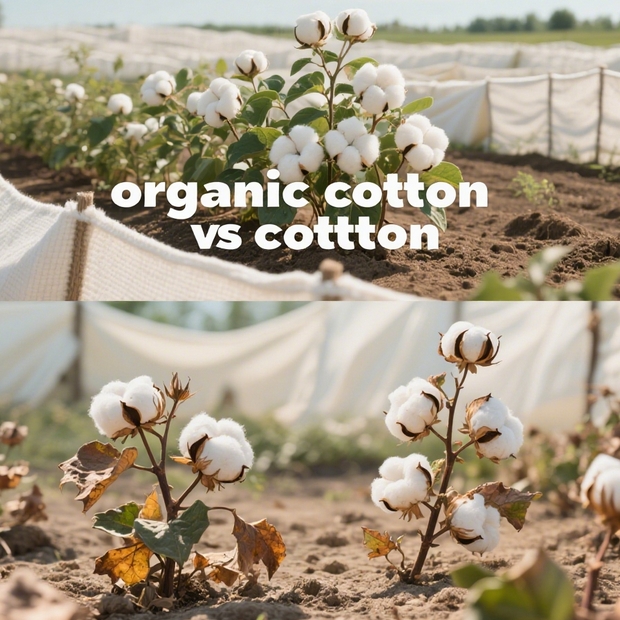When shopping for cotton facial wipes, medical dressings, or reusable towels, “100% Cotton” sounds reassuringly natural. But behind this label lies a critical divide—especially between conventional cotton spunlace and certified organic cotton spunlace. As hydroentangled nonwovens dominate skincare and hygiene markets, understanding this difference impacts your health, global ecosystems, and ethical sourcing.

Why Spunlace?
Spunlace (hydroentangled) nonwovens bond cotton fibers using high-pressure water jets—not chemicals or heat. This creates:
- Silky-soft textures (ideal for sensitive skin)
- Minimal lint with superior absorbency
- No chemical binders in the fabric
But similarities end here. The journey before hydroentangling—from seed to field—creates a profound split between conventional and organic options.
1. Seed to Soil: Where the Divide Begins
Conventional Cotton Spunlace:
- Uses GMO seeds (~80% of global cotton)
- Grown with synthetic pesticides/insecticides (consuming 16% of world’s insecticides)
- Relies on chemical fertilizers
- High water consumption with runoff pollution
Organic Cotton Spunlace (Certified):
- Non-GMO seeds only
- Zero synthetic pesticides/fertilizers
- Natural pest control (crop rotation, beneficial insects)
- Soil health focus with compost/cover crops
- Water conservation practices
Key Impact: Organic farming protects farmer health and biodiversity while reducing toxic runoff.
2. Processing: The Hidden Chemical Gap
Conventional Processing:
- Bleached with chlorine-based chemicals
- Uses optical brighteners (linked to skin irritation)
- Applies synthetic softeners
- No strict chemical residue limits
Organic Processing (GOTS Certified):
- Bleached only with hydrogen peroxide (non-toxic)
- Bans optical brighteners and heavy metals
- Uses biodegradable softeners
- Strict residue testing (≤ detectable limits)
- Wastewater treatment required
Why It Matters: Certified organic spunlace ensures no toxic residues contact skin—critical for babies, sensitive skin, or medical use.
3. Certifications: Trust But Verify
- Conventional: May have “100% Cotton” labels but no verified farming standards. OEKO-TEX® tests final products only.
- Organic (GOTS):
- Chain-of-custody tracking from farm to finish
- Annual onsite audits
- Social compliance (fair wages, no child labor)
- ≥95% organic fiber content
Procurement Tip: Demand GOTS Transaction Certificates (TCs) to verify authenticity.
4. Performance & Aesthetics Compared
| Feature | Conventional Cotton Spunlace | Organic Cotton Spunlace |
|---|---|---|
| Softness | High (chemical softeners) | Naturally high (no harsh processing) |
| Absorbency | Excellent | Excellent |
| Color | Bright white (optical brighteners) | Natural ivory (no additives) |
| Eco-Impact | High carbon/chemical footprint | Biodegradable, low toxicity |
Note: Organic cotton fibers may be slightly shorter but rarely affect nonwoven performance.
5. Cost Analysis: Why Organic Commands Premium
- Conventional: $3–5/kg
- Organic (GOTS): $7–12/kg
Drivers: Lower crop yields, certification costs, ethical labor, and eco-friendly processing.
Procurement Guidance:
“For medical/skincare applications, organic’s safety ROI outweighs cost. For industrial wipes, conventional may suffice.”
The Verdict: Which Should You Choose?
- Choose Conventional If:
Budget is priority • Bright-white aesthetics desired • Non-skin-contact applications - Choose Organic (GOTS) If:
Product safety is non-negotiable (baby, sensitive skin) • ESG commitments matter • Ethical transparency required • Brand premium positioning
The Future Is Organic:
As Zara, H&M, and healthcare brands adopt GOTS-certified nonwovens, organic cotton spunlace is shifting from niche to necessity. With every purchase, you vote for:
✅ Toxic-free ecosystems
✅ Farmer welfare
✅ Climate-resilient agriculture
Your choice isn’t just personal—it’s planetary.
